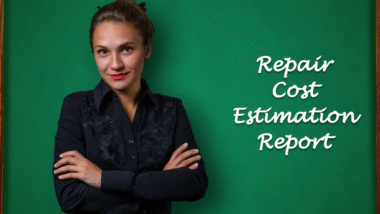A report evaluating a property’s After Repaired Value (ARV) using comparable sales data is typically structured using a Comparable Market Analysis (CMA) methodology, which forms the “Sales Approach” to property valuation. The ARV is the estimated value a property will appraise for once all necessary repairs and improvements have been completed.
The goal of this evaluation is to estimate the property’s value within a few thousand dollars so that the investor can calculate an appropriate offer to the seller.
After Repaired Value (ARV) Evaluation Report
I. Subject Property and Valuation Approach
The primary method for estimating ARV is the Sales Approach (or Market Approach), which uses market-driven information from willing buyers and sellers.
- Subject Property Details:This section records basic information, typically including the address and physical characteristics (e.g., size in square feet, bedrooms, baths, age, and construction type).
- Purpose:The investor’s concern is not the current appraisal value but what the property will appraise for after it has been fixed up.
II. Selection and Analysis of Comparable Sales Data
The analysis relies on locating recent sales of similar properties (“comparable sales” or “comps”) to establish a baseline value.
- Source Data Criteria:Comparable sales should be similar in construction and square footage, located within a mile or two of the subject property, and sold within the last six months or so.
- Data Gathering:Comparable sales information is often located through County Records or by working with a real estate agent who can provide a list from the MLS. Alternatively, a Broker Price Opinion (BPO) or an appraisal might be used, especially for large projects.
III. Comparable Market Analysis (CMA) Worksheet Adjustments
The core of the ARV calculation involves making dollar adjustments to the sales price of each comparable property based on its distinctions from the subject property.
The evaluation requires meticulous comparison of the subject property against each comparable property across various factors:
| Category | Specific Features Requiring Adjustment | Source(s) |
| Sales Information | Date of sale, concessions (sales/financing), fee simple/leasehold, age of improvements, special HOA assessments, and bonded assessments. | |
| Location/Area | Neighborhood trend, street amenities, lot size/shape, vehicle access, proximity to schools/churches/institutions, inside/corner lot status, utilities available, and environmental hazards/nuisances. | |
| Improvements (Post-Repair State) | Age of improvement, construction type, design/style, maintenance, obsolescence, exterior/interior conditions, garage/carpet, central AC/heating, gutters and downspouts, and windows/screens. | |
| Livable Space & Amenities | Gross livable square footage, number of bedrooms/baths, kitchen/appliances, living room, dining room, family room, basement/storage, attic/access, fireplace/woodstove, pool, fences, and patio/porch/deck. |
Adjustment Rules:
- Deductthe dollar value of a feature the comparable property has that the subject property does not.
- Addthe dollar value of a feature the comparable property does not have that the subject property has.
The sum of all adjustments results in the TOTAL Price Adjustment. This total adjustment is applied to the comparable property’s sale price to yield the Adjusted Price of Each Comparable.
IV. Final ARV Calculation (After Repaired Value)
Once the comparable sale prices have been adjusted, the final step is to synthesize these numbers to arrive at the estimated value of the subject property.
Two basic calculation methods are frequently employed to arrive at a rough, ballpark ARV:
1. Method 1: Average Sales Prices:
Add the adjusted sales prices of all three comparable properties and divide the total by three to find the average sales price, which serves as the Estimated Value by Average Sales Price.
2. Method 2: Estimated Value by Square Footage:
◦ Add the total sales prices of all three comparables and the total square footage of all three comparables.
◦ Divide the Total Sales Prices by the Total Square Footage to calculate the average cost per square foot.
◦ Multiply this Average Cost Per Square Foot by the square footage of the subject property to find the Estimated Value by Square Footage.
The lowest of these estimates should generally be used to calculate the maximum safe purchase offer. In advanced analysis tools, the After Repaired Value Estimate may be determined by a formula that averages the provided valuation information and bases the value on the subject property’s square footage. If the investor disagrees with the calculated ARV, they may manually Override the after-repaired value estimate in some tools.
The ultimate goal of estimating the ARV is to use it as the starting point for calculating the highest allowable offer by subtracting all estimated repair costs, closing costs (buying and selling), holding costs, and the required profit margin.
This form is designed to be a practical, step-by-step worksheet for real estate investors to complete during their analysis.
ARV Calculation Form: After Repaired Value Evaluation
Disclaimer: This form is a tool for investment analysis and is not a substitute for a formal appraisal.
- Subject Property & Valuation Approach
- Subject Property Address: _________________________________________________
- Date of Evaluation: _________________________
- Current Condition: □ As-Is | □ Post-Repair (Subject of this ARV)
- Post-Repair Square Footage (GLA): _________ sq ft
- Bedrooms/Bathrooms: _______ / _______
- Construction Type: _________________________ (e.g., Frame, Brick)
- Notable Planned Improvements:
Valuation Purpose: To estimate the property’s market value after all repairs and improvements are completed, using the Sales Comparison Approach.
- Selection of Comparable Sales (Comps)
- Comp Criteria:
- Location: Within ______ miles of subject.
- Sale Date: Within the last ______ months.
- Similar in size, age, and style.
| Comp ID | Property Address | Proximity to Subject | Date of Sale | Sale Price |
| Comp 1 | _________________________ | _________ miles | ___________ | $_________ |
| Comp 2 | _________________________ | _________ miles | ___________ | $_________ |
| Comp 3 | _________________________ | _________ miles | ___________ | $_________ |
III. Comparable Market Analysis (CMA) Worksheet & Adjustments
Adjustment Rules:
- Deduct from the Comp’s price for a feature IT HAS that the SUBJECT LACKS.
- Add to the Comp’s price for a feature IT LACKS that the SUBJECT HAS.
(Enter adjustment amounts in the cells below. Use positive (+) to add value, negative (-) to deduct value.)
| Adjustment Category | Feature | Comp 1 | Comp 2 | Comp 3 |
| Sales Information | Date of Sale (Market Trends) | $_________ | $_________ | $_________ |
| Seller Concessions/Financing | $_________ | $_________ | $_________ | |
| Location/Area | Neighborhood Desirability | $_________ | $_________ | $_________ |
| Lot Size/View | $_________ | $_________ | $_________ | |
| Improvements | Design & Appeal (Curb Appeal) | $_________ | $_________ | $_________ |
| Overall Condition (Post-Repair) | $_________ | $_________ | $_________ | |
| Garage/Carport (Size & Type) | $_________ | $_________ | $_________ | |
| Livable Space & Amenities | Square Footage (GLA) | $_________ | $_________ | $_________ |
| Bedrooms | $_________ | $_________ | $_________ | |
| Bathrooms | $_________ | $_________ | $_________ | |
| Kitchen Quality | $_________ | $_________ | $_________ | |
| Pool/Patio/Deck | $_________ | $_________ | $_________ | |
| Fireplace/Other Features | $_________ | $_________ | $_________ | |
| SUB-TOTAL ADJUSTMENTS | $_________ | $_________ | $_________ | |
| ORIGINAL SALE PRICE | $_________ | $_________ | $_________ | |
| ADJUSTED SALE PRICE (Sale Price + Sub-Total Adj.) |
$_________ | $_________ | $_________ |
- Final ARV Calculation
Method 1: Average of Adjusted Sale Prices
| Comp ID | Adjusted Sale Price |
| Comp 1 | $_________ |
| Comp 2 | $_________ |
| Comp 3 | $_________ |
| Total | $_________ |
Estimated ARV (Method 1): $_________
(Total Adjusted Sale Prices ÷ 3)
Method 2: Value by Square Footage
| Comp ID | Original Sale Price | Square Footage |
| Comp 1 | $_________ | _________ sq ft |
| Comp 2 | $_________ | _________ sq ft |
| Comp 3 | $_________ | _________ sq ft |
| Totals | $_________ | _________ sq ft |
Average Price per Sq Ft: $_________
(Total Sale Prices ÷ Total Square Footage)
Estimated ARV (Method 2): $_________
(Avg. Price/Sq Ft × Subject Property Sq Ft)
- Final ARV Determination & Investment Analysis
- Final Determined ARV: $_________
(Recommended: Use the LOWER of the two estimates or a reasoned average.) - Analyst’s Justification for Final ARV:
- Maximum Offer Calculation
(This section uses the Final ARV to determine a safe maximum purchase price.)
- A. Final Determined ARV: $_________
- B. Less: Estimated Repair Costs: – $_________
- C. Less: Estimated Holding Costs: – $_________ (e.g., loan payments, utilities, taxes)
- D. Less: Estimated Selling Costs: – $_________ (e.g., agent commissions, closing costs)
- E. Less: Desired Profit Margin: – $_________
Maximum Allowable Offer (MAO): $_________
(A – B – C – D – E)
Form Completed By: _________________________
Date: _________________________



